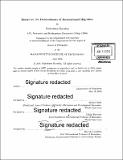Essays on the determinants of international migration
Author(s)
Shrestha, Maheshwor
DownloadFull printable version (15.83Mb)
Other Contributors
Massachusetts Institute of Technology. Department of Economics.
Advisor
Esther Duflo and Abhijit Banerjee.
Terms of use
Metadata
Show full item recordAbstract
This thesis explores the determinants of international migration of low-skilled workers, in particular, from Nepal to Malaysia and the Persian Gulf countries. The first chapter explores how potential migrants trade the risks (of mortality) with (financial) rewards of migrating abroad. The second chapter investigates how potential migrants learn about mortality rates abroad from the incidents of migrant deaths. The third chapter investigates how various 'push' and 'pull' shocks affect international migration when a low-cost low-return destination like India is also available for the migrants. Do potential migrants have accurate information about the risks and returns of migrating abroad? And, given the information they have, what is their revealed willingness to trade risks for higher earnings? To answer these questions, the first chapter sets up and analyzes a randomized field experiment among 3,319 potential work migrants from Nepal to Malaysia and the Persian Gulf countries. The experiment provides them with information on wages and mortality incidences in their choice destination and tracks their migration decision three months later. I find that potential migrants severely overestimate their mortality rate abroad, and that information on mortality incidences lowers this expectation. Potential migrants without prior foreign migration experience also overestimate their earnings potential abroad, and information on earnings lowers this expectation. Using exogenous variation in expectations for the inexperienced potential migrants generated by the experiment, I estimate migration elasticities of 0.7 in expected earnings and 0.5 in expected mortality. The experiment allows me to calculate the trade-off the inexperienced potential migrants make between earnings and mortality risk, and hence their value of a statistical life (VSL). The estimates range from $0.28 million to $0.54 million ($0.97m - $1.85m in PPP), which is a reasonable range for a poor population. At this revealed willingness to trade earnings for mortality risk, misinformation lowers migration. In the second chapter, I study how potential work migrants infer mortality rates from incidents of migrant deaths. Using administrative databases on deaths and outflows of work-migrants from Nepal to Malaysia and the Persian Gulf countries, I investigate how death of a migrant from a district affects subsequent migration from the district. After controlling for confounds using district-month, destination-month and district-destination fixed effects, I find two key features of the migration response. First, migrant death lowers migration from the district in the subsequent 12 months. There is limited substitution across destinations as well as spillovers to neighboring districts. Second, the migration response to a migrant death is stronger when there are more migrant deaths in the recent past. This indicates that the potential migrants over-weight recent deaths in forming their beliefs on mortality rates abroad. I then convert the migration response to change in perceived mortality rate abroad using the earnings elasticity of migration and the value of statistical life from the first chapter. I find that one migrant death increases the perceived mortality rate by 6.7 per thousand for a two-year migration episode. This response is too large to be explained by a model of rational Bayesian learning. Models of learning fallacy, such as belief in the law of 'small' numbers, in conjunction with other heuristic decision making rules, can explain high response to death as well as large observed overestimation of mortality rate. In the third chapter, I study migration choices in the presence of liquidity constraints and varying costs of migration. I present a simple theoretical framework that analyzes migration response to both push and pull factors in such settings. This framework implies that a shock to the push factors in the origin leads to differential observed response to migration to various destinations, as they affect different parts of the wealth distribution. I test the implications of this framework in context of international migration from Nepal using a panel of 452 villages observed at three points in the 2000s. I use rainfall shocks and deaths due to conflict as 'push' shocks and growth in manufacturing and construction in destination countries as the 'pull' shocks. I find that a rainfall shock that increases household income by US$ 100 increases migration to India by 54 percent but has no effect on migration elsewhere. Increase in conflict, which reduces consumption and amenity of the wealthier more, increases migration abroad, particularly from the urban areas. Increase in demand from the destination countries, particularly the Gulf countries and Malaysia has strong effects on migration to those destinations. These findings are consistent with the theoretical framework, and suggest presence of large liquidity constraints. Increase in income can boost migration to India whereas a reduction in cost of migration might increase profitable migration elsewhere. The responsiveness to 'pull' shocks suggests that households are willing to take advantage of these opportunities.
Description
Thesis: Ph. D., Massachusetts Institute of Technology, Department of Economics, 2016. Cataloged from PDF version of thesis. Includes bibliographical references (pages 163-167).
Date issued
2016Department
Massachusetts Institute of Technology. Department of EconomicsPublisher
Massachusetts Institute of Technology
Keywords
Economics.